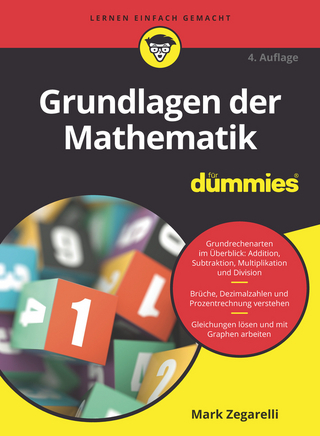
Prime Obsession
Joseph Henry Press (Verlag)
978-0-309-08549-6 (ISBN)
- Titel ist leider vergriffen;
keine Neuauflage - Artikel merken
In August 1859 Bernhard Riemann, a little-known 32-year old mathematician, presented a paper to the Berlin Academy titled: "On the Number of Prime Numbers Less Than a Given Quantity." In the middle of that paper, Riemann made an incidental remark — a guess, a hypothesis. What he tossed out to the assembled mathematicians that day has proven to be almost cruelly compelling to countless scholars in the ensuing years. Today, after 150 years of careful research and exhaustive study, the question remains. Is the hypothesis true or false?
Riemann's basic inquiry, the primary topic of his paper, concerned a straightforward but nevertheless important matter of arithmetic — defining a precise formula to track and identify the occurrence of prime numbers. But it is that incidental remark — the Riemann Hypothesis — that is the truly astonishing legacy of his 1859 paper. Because Riemann was able to see beyond the pattern of the primes to discern traces of something mysterious and mathematically elegant shrouded in the shadows — subtle variations in the distribution of those prime numbers. Brilliant for its clarity, astounding for its potential consequences, the Hypothesis took on enormous importance in mathematics. Indeed, the successful solution to this puzzle would herald a revolution in prime number theory. Proving or disproving it became the greatest challenge of the age.
It has become clear that the Riemann Hypothesis, whose resolution seems to hang tantalizingly just beyond our grasp, holds the key to a variety of scientific and mathematical investigations. The making and breaking of modern codes, which depend on the properties of the prime numbers, have roots in the Hypothesis. In a series of extraordinary developments during the 1970s, it emerged that even the physics of the atomic nucleus is connected in ways not yet fully understood to this strange conundrum. Hunting down the solution to the Riemann Hypothesis has become an obsession for many — the veritable "great white whale" of mathematical research. Yet despite determined efforts by generations of mathematicians, the Riemann Hypothesis defies resolution.
Alternating passages of extraordinarily lucid mathematical exposition with chapters of elegantly composed biography and history, Prime Obsession is a fascinating and fluent account of an epic mathematical mystery that continues to challenge and excite the world. Posited a century and a half ago, the Riemann Hypothesis is an intellectual feast for the cognoscenti and the curious alike. Not just a story of numbers and calculations, Prime Obsession is the engrossing tale of a relentless hunt for an elusive proof — and those who have been consumed by it.Table of Contents
Front Matter
Part I: The Prime Number Theorem
1. Card Trick
2. The Soil, the Crop
3. The Prime Number Theorem
4. On the Shoulders of Giants
5. Riemann's Zeta Function
6. The Great Fusion
7. The Golden Key, and an Improved Prime Number Theorem
8. Not Altogether Unworthy
9. Domain Stretching
10. A Proof and a Turning Point
Part II: The Riemann Hypothesis
11. Nine Zulu Queens Ruled China
12. Hilber's Eighth Problem
13. The Argument Ant and the Value Ant
14. In the Grip of an Obsession
15. Big Oh and Möbius Mu
16. Climbing the Critical Line
17. A Little Algebra
18. Number Theory Meets Quantum Mechanics
19. Turning the Golden Key
20. The Riemann Operator and Other Approaches
21. The Error Term
22. Either It's True, or Else It Isn't
Epilogue
Notes
Appendix: The Riemann Hypothesis in Song
Picture Credits
Index
Pictures
John Derbyshire
1 Front Matter; 2 Part I: The Prime Number Theorem; 3 1. Card Trick; 4 2. The Soil, the Crop; 5 3. The Prime Number Theorem; 6 4. On the Shoulders of Giants; 7 5. Riemann's Zeta Function; 8 6. The Great Fusion; 9 7. The Golden Key, and an Improved Prime Number Theorem; 10 8. Not Altogether Unworthy; 11 9. Domain Stretching; 12 10. A Proof and a Turning Point; 13 Part II: The Riemann Hypothesis; 14 11. Nine Zulu Queens Ruled China; 15 12. Hilber's Eighth Problem; 16 13. The Argument Ant and the Value Ant; 17 14. In the Grip of an Obsession; 18 15. Big Oh and Mobius Mu; 19 16. Climbing the Critical Line; 20 17. A Little Algebra; 21 18. Number Theory Meets Quantum Mechanics; 22 19. Turning the Golden Key; 23 20. The Riemann Operator and Other Approaches; 24 21. The Error Term; 25 22. Either It's True, or Else It Isn't; 26 Epilogue; 27 Notes; 28 Appendix: The Riemann Hypothesis in Song; 29 Picture Credits; 30 Index; 31 Pictures
| Erscheint lt. Verlag | 15.4.2003 |
|---|---|
| Verlagsort | Washington |
| Sprache | englisch |
| Maße | 140 x 216 mm |
| Themenwelt | Literatur ► Biografien / Erfahrungsberichte |
| Sachbuch/Ratgeber ► Geschichte / Politik | |
| Sachbuch/Ratgeber ► Natur / Technik | |
| Mathematik / Informatik ► Mathematik ► Allgemeines / Lexika | |
| Mathematik / Informatik ► Mathematik ► Arithmetik / Zahlentheorie | |
| Mathematik / Informatik ► Mathematik ► Mathematische Spiele und Unterhaltung | |
| ISBN-10 | 0-309-08549-7 / 0309085497 |
| ISBN-13 | 978-0-309-08549-6 / 9780309085496 |
| Zustand | Neuware |
| Haben Sie eine Frage zum Produkt? |
aus dem Bereich


